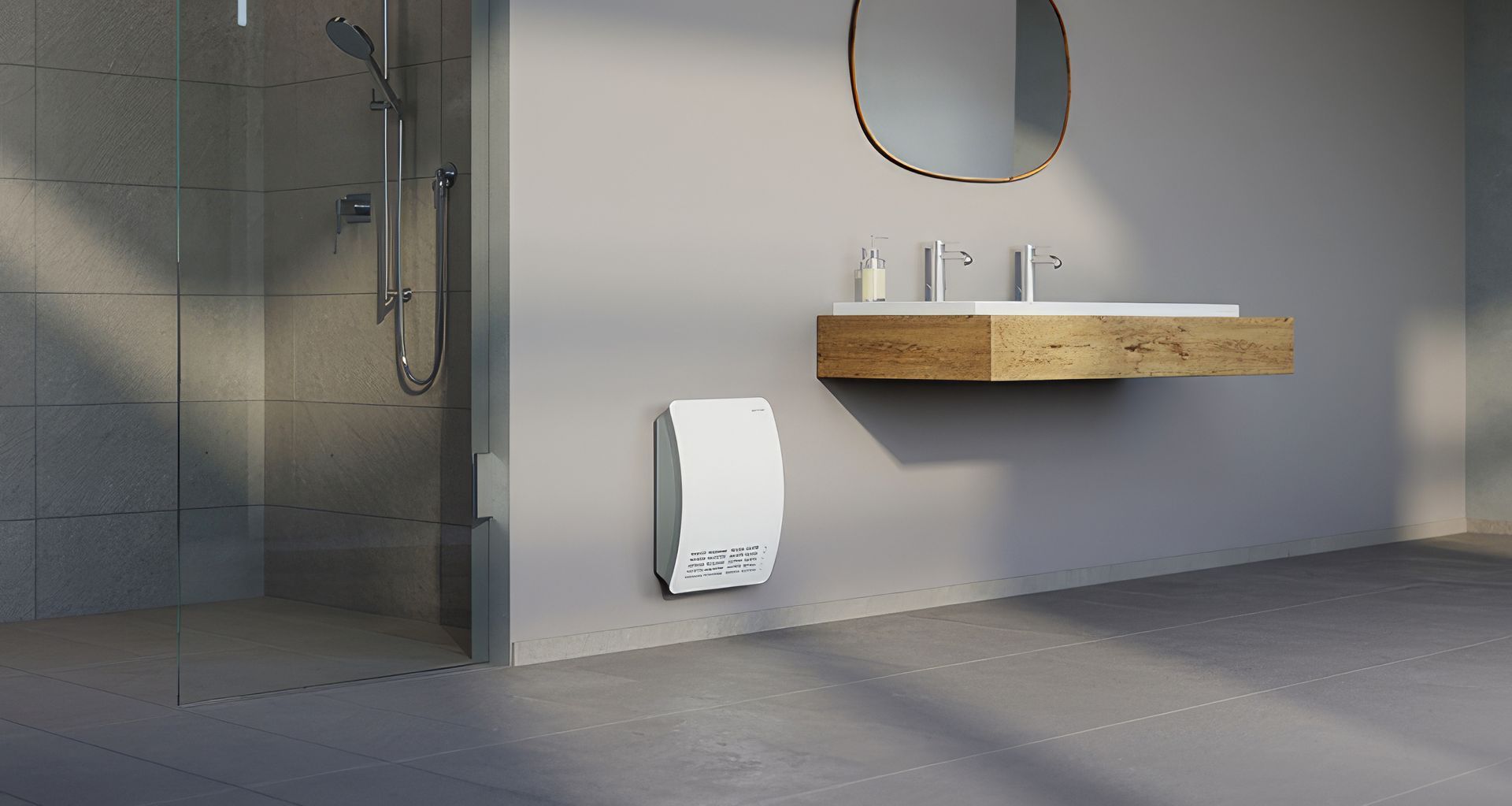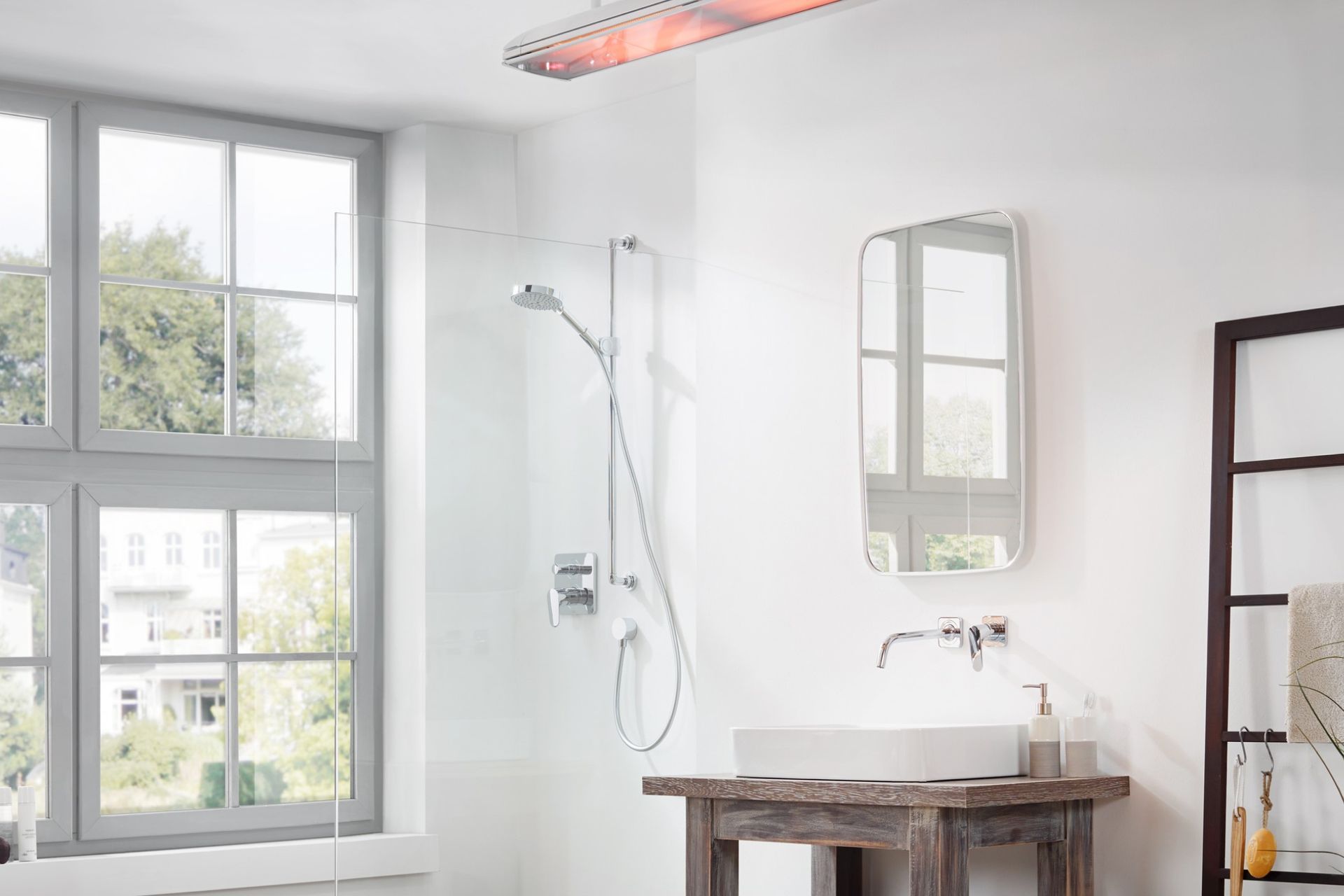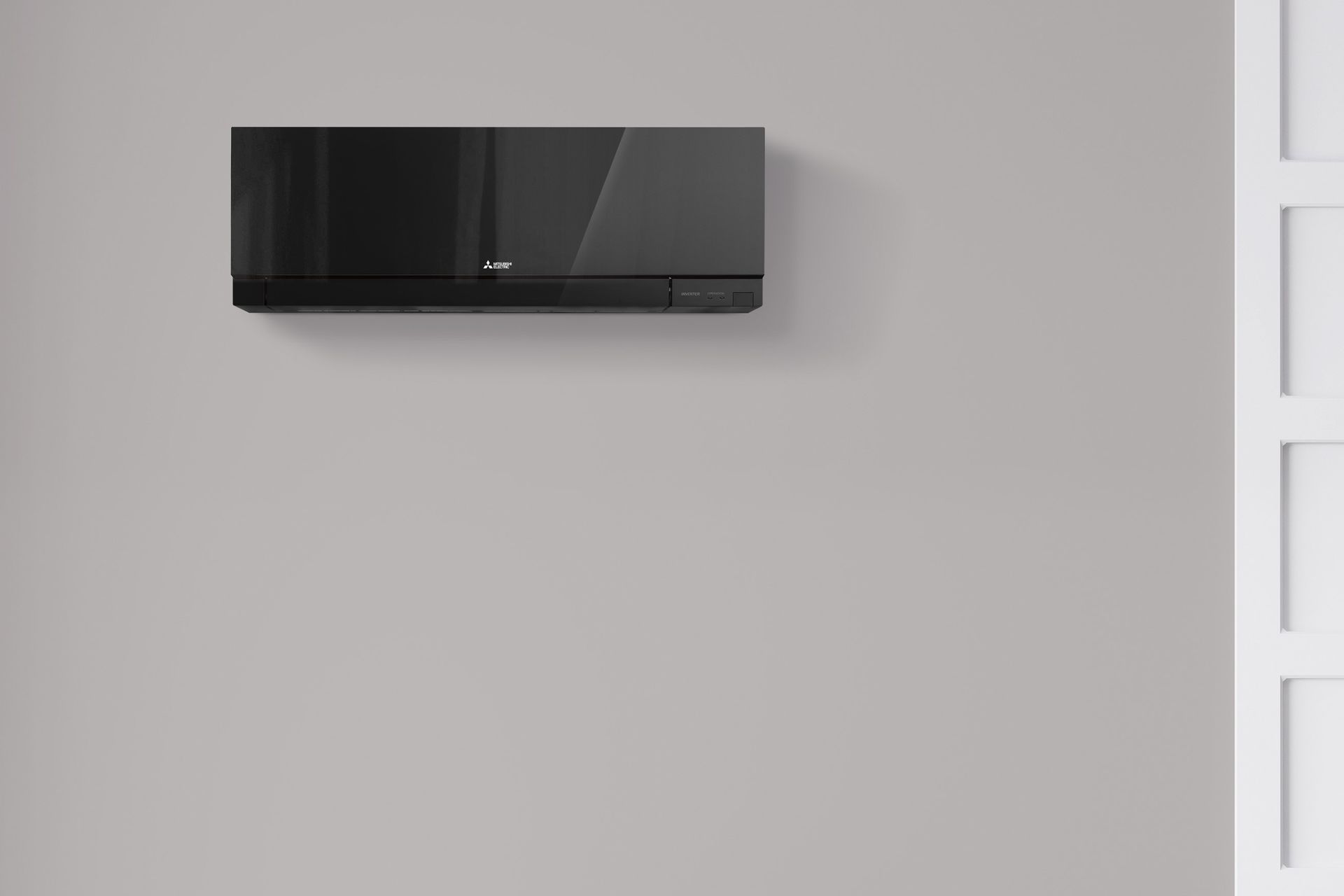7 bathroom heating options and what they'll cost you to run
Written by
08 August 2023
•
9 min read

There are a number of different bathroom heating options available in New Zealand, each with its own unique traits and benefits. Some are multi-functional products, serving a number of functions, while others are purely bathroom heaters, designed to tackle the main task at hand. Understanding exactly what these different heating options are and how much they'll cost you to run will help you to decide which ones are right for you to heat your bathroom in a comfortable and cost-effective way.
1. Heated Towel Rails
Heated towel rails are a modern-day necessity for most homeowners in New Zealand. They not only keep your towels toasty and dry but add warmth and comfort to the bathroom too.
They come in a wide range of sizes, typically reflected in the number of bars from single (solo) towel rails to those with 11 bars or more. You'll also find different styles like traditional horizontal bar towel rails and contemporary vertical bar towel rails, as well as a range of colours and finishes to choose from.
How much does a heated towel rail cost to run?
The most common type of heated towel rail on the market in New Zealand is the electric heated towel rail, for which the running costs are fairly easy to estimate with the following formula.
Running Cost (per day) = Wattage (in kW) × Hours of Use × Cost per kWh
For example, if you have a heated towel rail with a wattage of 150 watts, and you use it for 2 hours a day your daily running cost calculation will look something like this:
Running Cost = 0.15 kW × 2 hours × $0.325/kWh* = $0.0975 per day
*(the average electricity rate in New Zealand of $0.325 per kWh has been used throughout this article)
2. Electric Heated Mirrors
Electric heated mirrors are another multi-functional option that many are turning to for their versatility and convenience. The main purpose of these is actually to prevent mirrors from fogging up (often referred to as demisting mirrors) but they also help keep a bathroom warm too.
They are available in a wide range of styles, shapes and sizes giving you plenty of options to match your bathroom design. They are also easy to operate and often come with additional features like LED lights and touch controls.
How much does an electric heated mirror cost to run?
Electric heated mirrors are designed to be energy efficient making them a cost-effective type of bathroom heater. You can find models with a heating output anywhere between 30 - 150 watts with the daily running cost easily calculated using the following formula.
Running Cost (per day) = Wattage (in kW) × Hours of Use × Cost per kWh
Using this formula and a 75 watt mirror demister at an hour every day comes to the following estimate:
Running Cost = 0.075 kW × 1 hours × $0.325/kWh* = $0.0244 per day
Find a stylish demister mirror for your bathroom on ArchiPro

3. Heat Lamps
The heat lamp is a common lighting fixture used as a bathroom heating solution, especially in combination with ventilation fans. They direct radiating heat outwards and are effective at quickly warming up a bathroom when time is of the essence.
They are very good for localised heat and are typically placed above the front door of a shower enclosure, offering much-needed warmth after showering. Like most bathroom heaters, they are often used seasonally during the colder months of the year.
How much does a heat lamp cost to run?
Heat lamps, when combined with ventilation fans, are often used in pairs which is something that needs to be included in the calculation for running costs. Bathroom heat lamps typically have a wattage of around 250 watts so the following calculation gives you a fair estimate.
Running Cost (per day) = Wattage (in kW) × Number of Heat Lamps x Hours of Use × Cost per kWh
So if you have two heat lamps that are used for an hour each day, your daily running cost will be the following:
Running Cost = 0.25 kW × 2 heat lamps x 1 hour × $0.325/kWh* = $0.1625 per day
Related article: The best ways to keep your bathroom warm this winter

4. Wall-Mounted Fan Heaters
Wall-mounted bathroom fan heaters are another popular choice in New Zealand for their ability to provide quick and efficient heating in bathrooms. More recent models often come with thermostats and timers, making them more energy-efficient too.
The instant heat they provide can turn cold air warm very quickly and as a wall-mounted fixture, they also free up valuable floor space.
How much does a wall-mounted fan heater cost to run?
Bathroom fan heaters typically have a heating output of around 2,000 - 2,400 watts though you can find some with adjustments that will bring this down if desired. They too will probably be used on a seasonal basis and in short bursts given the fact they offer instant heat. The following basic formula is therefore an appropriate one to use.
Running Cost (per day) = Wattage (in kW) × Hours of Use × Cost per kWh
For a 2,000 watt bathroom fan heater used for half an hour each day, the running cost you can expect will be:
Running Cost = 2.0 kW × 0.5 hour × $0.325/kWh* = $0.325 per day
Browse a great selection of the latest bathroom heaters on ArchiPro
5. Infrared Heaters
Infrared bathroom heaters are an efficient option for targeted heating, especially in smaller bathrooms. They work by using infrared radiation to heat objects directly, rather than the air, similar to the sun's heat.
Wall or ceiling mounted, infrared bathroom heaters are another option that can provide instant warmth at the flick of a switch. They also have a lower surface temperature compared to some other bathroom heaters making them a good choice with safety in mind.
How much does an infrared heater cost to run?
Infrared heaters are available in a range of heating outputs, starting anywhere from 800 - 2,400 watts making them slightly lower on average compared to bathroom fan heaters. The same formula used to calculate the running costs for those, work for these.
Running Cost (per day) = Wattage (in kW) × Hours of Use × Cost per kWh
Using a mid-range 1,600 watt infrared heater as an example at an hour each day, you can expect the following daily cost.
Running Cost = 1.6 kW × 0.5 hour × $0.325/kWh* = $0.26 per day
Related article: Bathroom renovation costs in New Zealand — a full breakdown

6. Heat Pumps
Heat pumps are another viable way to turn a cold bathroom into a warm one with the ability to maintain a comfortable temperature, day or night. Used prolifically in New Zealand in bedrooms and living spaces, more and more of them are starting to find their place in bathrooms too.
One of the great things about heat pumps is the number of options they give you, not just as bathroom heating systems, but for cooling and dehumidifying as well. This means they can be used all year round, for different purposes to meet your changing needs.
How much does a heat pump cost to run?
The cost to run a bathroom heat pump in New Zealand is based on many of the factors already discussed like power capacity, hours of use etc. Heat pumps also usually come with a star efficiency rating which is a good thing to look out for as a gauge for energy efficiency.
To estimate the running cost of a bathroom heat pump, you can use the following formula.
Running Cost (per day) = Heat Pump Capacity (in kW) × Hours of Use × Cost per kWh
Heat pumps typically come with a capacity of between 2.5kW - 6.0kW though high-powered ones are rarely required for bathrooms which tend to be smaller-sized spaces.
With this in mind, taking a 3.5kW Heat pump with 2 hours a day of use, you'll end up with the following estimate.
Running Cost = 3.5kW × 2 hours × $0.325/kWh* = $2.275 per day
Related article: The true cost of buying and installing a heat pump in New Zealand
7. Underfloor Heating
Underfloor heating is becoming increasingly popular in New Zealand bathrooms, especially for those that are looking to create a luxurious, spa-like environment. It provides consistent heating underfoot while making your bathroom warmer too.
There are two main types of underfloor heating systems — electric underfloor heating and hydronic underfloor heating, the latter of which uses a system of heated water pipes instead of heating cables to warm the flooring.
How much does underfloor heating cost to run?
The cost to run underfloor heating can vary widely based on the type of heating system (electric or hydronic), the size of the floor being heated, the insulation of the room and the chosen temperature settings.
For an electric underfloor heating system, you are typically looking at a heating output of 100-150 watts per square metre. With that in mind, using a 100 watt system in a bathroom of 7 square metres at four hours a day will cost you the following.
Running Cost = 0.1kW × 7 square metres x 4 hours × $0.325/kWh* = $0.91 per day
Costs for hydronic systems are harder to estimate given the water is heated at a central heat source (like a boiler or heat pump), typically used to heat all the floors of an entire home. Some boiler systems also use different fuel types like wood pellets, gas and sometimes even diesel adding another set of variables into the mix.
Broadly speaking, they have a very good reputation with respect to running costs and are generally seen as even more cost-effective than electric systems in the long term. They do have higher upfront costs however which will need to be factored in.
With hydronic systems, it's best to have conversations with a range of trusted professionals to get a clear understanding of the likely ongoing costs as well as the installation pricing before making a decision.
Related article: Electric or water underfloor heating? A comparison of comfort and efficiency

The best bathroom heating options in New Zealand and their running costs to help you decide
With everything covered from heated towel rails to wall mounted electric heaters and heat pumps, you now have a comprehensive understanding of all the different types of bathroom heating solutions available in New Zealand and how much they'll cost to run. It should be noted that while the average price of power has been used in our calculations, some providers offer off-peak rates of $0.15/kWh or less which means you can save more money using the bathroom at these times where possible.
With all this information at your fingertips, you now have the ability to plan and budget accordingly, picking the best option that suits your home to create a cosy and warm bathroom all year round.
Find all the best bathroom heating and ventilation products on ArchiPro


